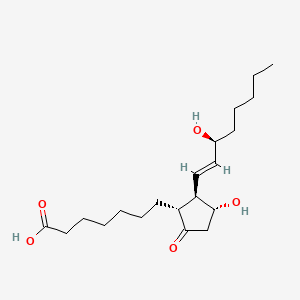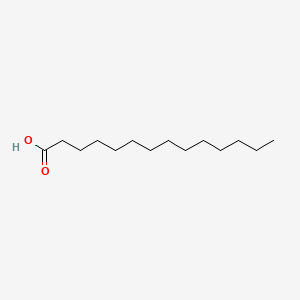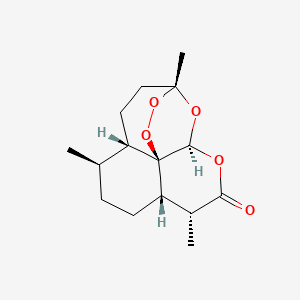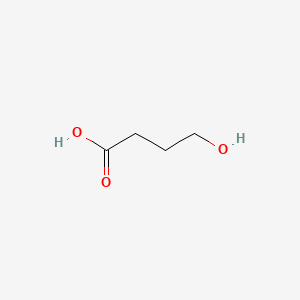
|
stearic acid |
stearic acid is a lipid of Fatty Acyls (FA) class. Stearic acid is associated with abnormalities such as Helminthiasis, Exanthema, Chronic disease, Obesity and Dyslipidemias. The involved functions are known as acyltransferase activity, Mutation, Cell division, cell fate and Fatty Acid Metabolism. Stearic acid often locates in membrane fraction, Mouse Liver, Membrane, Body tissue and Endoplasmic reticulum, membrane. The associated genes with stearic acid are Homologous Gene, ACLY gene, Transgenes, FATE1 gene and Alleles. The related lipids are Lysophospholipids, Stearic acid, Fatty Acids, cis-vaccenic acid and Phosphatidylserines. The related experimental models are Knock-out. |
5692 |

|
4-hydroxynonenal |
4-hydroxynonenal is a lipid of Fatty Acyls (FA) class. 4-hydroxynonenal is associated with abnormalities such as Chronic disease, Obesity, Diabetes, Acquired Immunodeficiency Syndrome and Lung diseases. The involved functions are known as protein expression, Glycolysis, mRNA Expression, Regulation and Mitochondrion in division. 4-hydroxynonenal often locates in Muscle, Mitochondria, Adipose tissue, Head and Mouse Muscle. The associated genes with 4-hydroxynonenal are STAT3 gene, SIRT1 gene, PGC gene, IL6 gene and cytochrome c''. The related lipids are Lipopolysaccharides, Lipid Peroxides, Promega, Membrane Lipids and oxidized lipid. The related experimental models are Mouse Model, Knock-out, Transgenic Model, Disease model and Rodent Model. |
5685 |

|
quercetin |
quercetin is a lipid of Polyketides (PK) class. Quercetin is associated with abnormalities such as Coronary heart disease, Myocardial Infarction, Cirrhosis, Coronary Arteriosclerosis and Vascular ring. The involved functions are known as Vasodilation, physiological aspects, Fermentation, Process and Ingredient. Quercetin often locates in Arterial system, Endothelium, Skin, Endothelium, Vascular and Tissue specimen. The associated genes with quercetin are P4HTM gene, SULT gene, UGT1A1 gene, ARHGAP26 gene and PLXNB1 gene. The related lipids are blood lipid, Promega, Steroids, Phosphatidylserines and Fatty Acids. The related experimental models are Knock-out, Mouse Model, Xenograft Model, Tissue Model and Cancer Model. |
5377 |

|
Prostaglandin e1 |
Prostaglandin e1 is a lipid of Fatty Acyls (FA) class. The involved functions are known as Protein Expression and Down-Regulation. |
5126 |

|
Tetradecanoic acid |
Tetradecanoic acid is a lipid of Fatty Acyls (FA) class. Tetradecanoic acid is associated with abnormalities such as Chronic lung disease, Infection, Spastic syndrome, Diabetes and Cardiovascular Diseases. The involved functions are known as Fatty acid biosynthetic process, Anabolism, lung alveolus development, 5-(carboxyamino)imidazole ribonucleotide mutase activity and Homeostasis. Tetradecanoic acid often locates in Structure of parenchyma of lung, Blood, Head, Membrane and Cytoplasmic matrix. The associated genes with Tetradecanoic acid are SLC33A1 gene, SFTPA1 gene, P4HTM gene, Polypeptides and GPR132 gene. The related lipids are Fatty Acids, Nonesterified Fatty Acids, palmitoleic acid, Phosphatidylglycerols and Butanols. |
5058 |

|
nystatin |
nystatin is a lipid of Polyketides (PK) class. Nystatin is associated with abnormalities such as Virus Diseases, Infection, Candidiasis, Leukopenia and Mycoses. The involved functions are known as Membrane Potentials, Uptake, Flow or discharge, Cell membrane potential and adenine transport. Nystatin often locates in Cell Wall, Plasma membrane, Extracellular, Membrane and Virion. The associated genes with nystatin are Genome, Integral Membrane Proteins, Amino Acids, Basic, P4HTM gene and Homologous Gene. The related lipids are Sterols, Liposomes, Membrane Lipids, Sphingolipids and 1,2-oleoylphosphatidylcholine. The related experimental models are Knock-out and Xenograft Model. |
4890 |

|
Artemisin |
Artemisin is a lipid of Prenol Lipids (PR) class. Artemisin is associated with abnormalities such as Malaria, Falciparum. The involved functions are known as Pressure- physical agent and secondary metabolic process. |
4738 |

|
apigenin |
apigenin is a lipid of Polyketides (PK) class. Apigenin is associated with abnormalities such as Morphologically altered structure, Chimera disorder, Hypertensive disease, infection induced and Infection. The involved functions are known as inhibitors, Gene Expression, Process, Metabolic Inhibition and Cell Death. Apigenin often locates in Vacuole, Cytoplasmic matrix, Cytoplasm, Tissue membrane and Membrane. The associated genes with apigenin are MSMP gene, BCL2 gene, PTGS2 gene, Chromatin and SLC33A1 gene. The related lipids are Lipopolysaccharides, Steroids, 1-Butanol, agosterol A and Butyrates. The related experimental models are Mouse Model, Tissue Model, Knock-out, Xenograft Model and Disease model. |
4250 |

|
alpha-linolenic acid |
Alpha-linolenic acid is a lipid of Fatty Acyls (FA) class. Alpha-linolenic acid is associated with abnormalities such as Coronary heart disease, abnormal fragmented structure, Arterial thrombosis and Subarachnoid Hemorrhage. The involved functions are known as Anabolism, Signal, Transcription, Genetic, Saturated and Regulation. Alpha-linolenic acid often locates in Blood, Body tissue, Plasma membrane, Hepatic and peroxisome. The associated genes with alpha-linolenic acid are FATE1 gene, volicitin, CYP2U1 gene, CYP1A2 gene and CYP2J2 gene. The related lipids are Fatty Acids, Dietary Fatty Acid, stearidonic acid and Fatty Acids, Nonesterified. |
4231 |

|
4-hydroxy-butyric acid |
4-hydroxy-butyric acid is a lipid of Fatty Acyls (FA) class. |
3927 |









